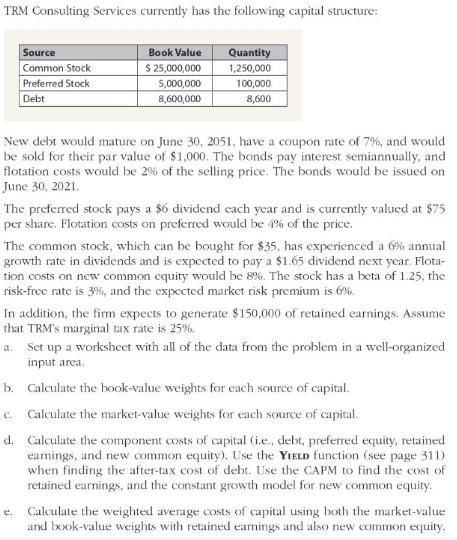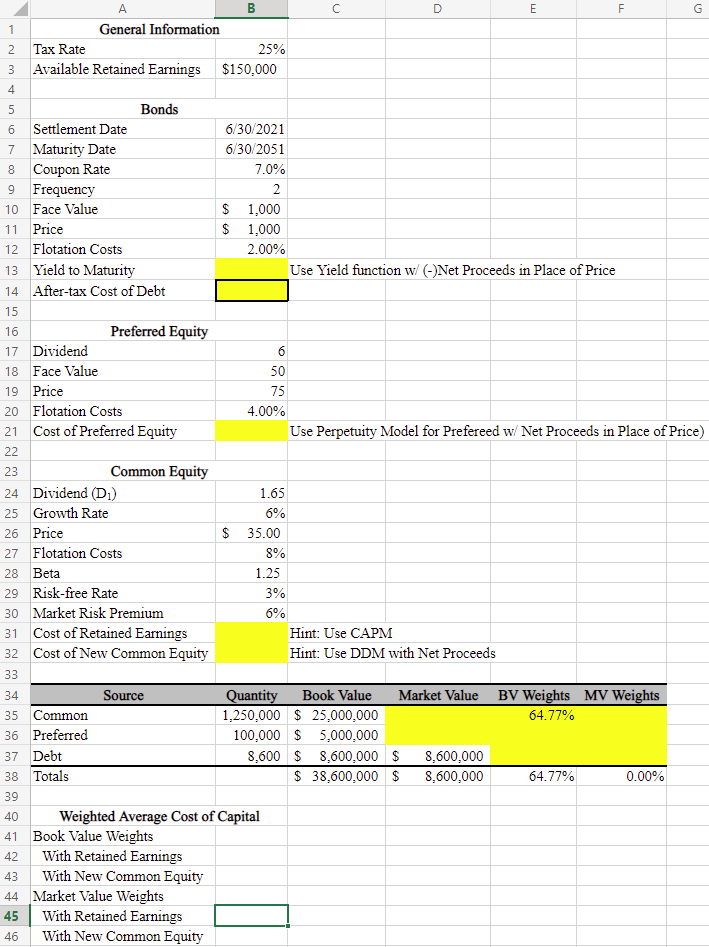

TRM Consulting Services currently has the following capital structure: Source Common Stock Preferred Stock Debt Book Value $ 25,000,000 5,000,000 8,600,000 Quantity 1,250,000 100,000 8,600 New debt would mature on June 30, 2051, have a coupon rate of 7%, and would be sold for their par value of $1,000. The bonds pay interest semiannually, and flotation costs would be 2% of the selling price. The bonds would be issued on June 30, 2021 The preferred stock pays a $6 dividend cach year and is currently valued at $75 per share. Flotation costs on preferred would be 4% of the price. The common stock, which can be bought for $35, has experienced a 6% annual growth rate in dividends and is expected to pay a $1.65 dividend next year. Flota- tion costs on new common equity would be 8%. The stock has a beta of 1.25, the risk-free rate is 3%, and the expected market risk premium is 6%. In addition, the firm expects to generate $150,000 of retained earnings. Assume that TRM's marginal tax rate is 25%. a. Set up a worksheet with all of the data from the problem in a well-organized input area. b. Calculate the book-value weights for each source of capital. C. Calculate the market-value weights for each source of capital. d. Calculate the component costs of capital (i.e., debt, preferred equity, retained earnings, and new common equity). Use the YIELD function (see page 311) when finding the after-tax cost of debt. Use the CAPM to find the cost of retained earnings, and the constant growth model for new common equity. Calculate the weighted average costs of capital using both the market value and book-value weights with retained earnings and also new common equity. e. A 2 5 B E F 1 General Information Tax Rate 25% 3 Available Retained Earnings $150.000 4 Bonds 6 Settlement Date 6/30/2021 7 Maturity Date 6/30/2051 8 Coupon Rate 7.0% 9 Frequency 2 10 Face Value $ 1,000 11 Price $ 1.000 12 Flotation Costs 2.00% 13 Yield to Maturity Use Yield function w/ (-) Net Proceeds in Place of Price 14 After-tax Cost of Debt 15 16 Preferred Equity 17 Dividend 6 18 Face Value 50 19 Price 75 20 Flotation Costs 4.00% 21 Cost of Preferred Equity Use Perpetuity Model for Prefereed w/ Net Proceeds in Place of Price) 22 23 Common Equity 24 Dividend (D1) 1.65 25 Growth Rate 6% 26 Price $ 35.00 27 Flotation Costs 8% 28 Beta 1.25 29 Risk-free Rate 3% 30 Market Risk Premium 6% 31 Cost of Retained Earnings Hint: Use CAPM 32 Cost of New Common Equity Hint: Use DDM with Net Proceeds 33 34 Source Quantity Book Value Market Value BV Weights MV Weights 35 Common 1,250,000 $ 25,000,000 64.77% 36 Preferred 100,000 $5,000,000 37 Debt 8,600 $ 8,600,000 $ 8,600,000 38 Totals $ 38,600,000 $ 8.600.000 64.77% 0.00% 39 40 Weighted Average Cost of Capital 41 Book Value Weights 42 With Retained Earnings 43 With New Common Equity 44 Market Value Weights 45 With Retained Earnings 46 With New Common Equity TRM Consulting Services currently has the following capital structure: Source Common Stock Preferred Stock Debt Book Value $ 25,000,000 5,000,000 8,600,000 Quantity 1,250,000 100,000 8,600 New debt would mature on June 30, 2051, have a coupon rate of 7%, and would be sold for their par value of $1,000. The bonds pay interest semiannually, and flotation costs would be 2% of the selling price. The bonds would be issued on June 30, 2021 The preferred stock pays a $6 dividend cach year and is currently valued at $75 per share. Flotation costs on preferred would be 4% of the price. The common stock, which can be bought for $35, has experienced a 6% annual growth rate in dividends and is expected to pay a $1.65 dividend next year. Flota- tion costs on new common equity would be 8%. The stock has a beta of 1.25, the risk-free rate is 3%, and the expected market risk premium is 6%. In addition, the firm expects to generate $150,000 of retained earnings. Assume that TRM's marginal tax rate is 25%. a. Set up a worksheet with all of the data from the problem in a well-organized input area. b. Calculate the book-value weights for each source of capital. C. Calculate the market-value weights for each source of capital. d. Calculate the component costs of capital (i.e., debt, preferred equity, retained earnings, and new common equity). Use the YIELD function (see page 311) when finding the after-tax cost of debt. Use the CAPM to find the cost of retained earnings, and the constant growth model for new common equity. Calculate the weighted average costs of capital using both the market value and book-value weights with retained earnings and also new common equity. e. A 2 5 B E F 1 General Information Tax Rate 25% 3 Available Retained Earnings $150.000 4 Bonds 6 Settlement Date 6/30/2021 7 Maturity Date 6/30/2051 8 Coupon Rate 7.0% 9 Frequency 2 10 Face Value $ 1,000 11 Price $ 1.000 12 Flotation Costs 2.00% 13 Yield to Maturity Use Yield function w/ (-) Net Proceeds in Place of Price 14 After-tax Cost of Debt 15 16 Preferred Equity 17 Dividend 6 18 Face Value 50 19 Price 75 20 Flotation Costs 4.00% 21 Cost of Preferred Equity Use Perpetuity Model for Prefereed w/ Net Proceeds in Place of Price) 22 23 Common Equity 24 Dividend (D1) 1.65 25 Growth Rate 6% 26 Price $ 35.00 27 Flotation Costs 8% 28 Beta 1.25 29 Risk-free Rate 3% 30 Market Risk Premium 6% 31 Cost of Retained Earnings Hint: Use CAPM 32 Cost of New Common Equity Hint: Use DDM with Net Proceeds 33 34 Source Quantity Book Value Market Value BV Weights MV Weights 35 Common 1,250,000 $ 25,000,000 64.77% 36 Preferred 100,000 $5,000,000 37 Debt 8,600 $ 8,600,000 $ 8,600,000 38 Totals $ 38,600,000 $ 8.600.000 64.77% 0.00% 39 40 Weighted Average Cost of Capital 41 Book Value Weights 42 With Retained Earnings 43 With New Common Equity 44 Market Value Weights 45 With Retained Earnings 46 With New Common Equity








